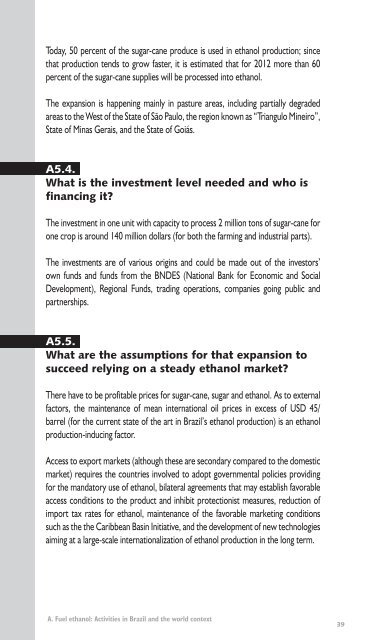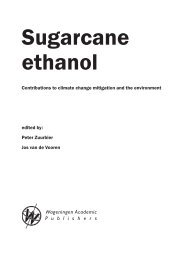Production and use of fuel ethanol in Brazil - BAFF
Production and use of fuel ethanol in Brazil - BAFF
Production and use of fuel ethanol in Brazil - BAFF
Create successful ePaper yourself
Turn your PDF publications into a flip-book with our unique Google optimized e-Paper software.
Today, 50 percent <strong>of</strong> the sugar-cane produce is <strong>use</strong>d <strong>in</strong> <strong>ethanol</strong> production; s<strong>in</strong>ce<br />
that production tends to grow faster, it is estimated that for 2012 more than 60<br />
percent <strong>of</strong> the sugar-cane supplies will be processed <strong>in</strong>to <strong>ethanol</strong>.<br />
The expansion is happen<strong>in</strong>g ma<strong>in</strong>ly <strong>in</strong> pasture areas, <strong>in</strong>clud<strong>in</strong>g partially degraded<br />
areas to the West <strong>of</strong> the State <strong>of</strong> São Paulo, the region known as “Triangulo M<strong>in</strong>eiro”,<br />
State <strong>of</strong> M<strong>in</strong>as Gerais, <strong>and</strong> the State <strong>of</strong> Goiás.<br />
A5.4.<br />
What is the <strong>in</strong>vestment level needed <strong>and</strong> who is<br />
f<strong>in</strong>anc<strong>in</strong>g it?<br />
The <strong>in</strong>vestment <strong>in</strong> one unit with capacity to process 2 million tons <strong>of</strong> sugar-cane for<br />
one crop is around 140 million dollars (for both the farm<strong>in</strong>g <strong>and</strong> <strong>in</strong>dustrial parts).<br />
The <strong>in</strong>vestments are <strong>of</strong> various orig<strong>in</strong>s <strong>and</strong> could be made out <strong>of</strong> the <strong>in</strong>vestors’<br />
own funds <strong>and</strong> funds from the BNDES (National Bank for Economic <strong>and</strong> Social<br />
Development), Regional Funds, trad<strong>in</strong>g operations, companies go<strong>in</strong>g public <strong>and</strong><br />
partnerships.<br />
A5.5.<br />
What are the assumptions for that expansion to<br />
succeed rely<strong>in</strong>g on a steady <strong>ethanol</strong> market?<br />
There have to be pr<strong>of</strong>itable prices for sugar-cane, sugar <strong>and</strong> <strong>ethanol</strong>. As to external<br />
factors, the ma<strong>in</strong>tenance <strong>of</strong> mean <strong>in</strong>ternational oil prices <strong>in</strong> excess <strong>of</strong> USD 45/<br />
barrel (for the current state <strong>of</strong> the art <strong>in</strong> <strong>Brazil</strong>’s <strong>ethanol</strong> production) is an <strong>ethanol</strong><br />
production-<strong>in</strong>duc<strong>in</strong>g factor.<br />
Access to export markets (although these are secondary compared to the domestic<br />
market) requires the countries <strong>in</strong>volved to adopt governmental policies provid<strong>in</strong>g<br />
for the m<strong>and</strong>atory <strong>use</strong> <strong>of</strong> <strong>ethanol</strong>, bilateral agreements that may establish favorable<br />
access conditions to the product <strong>and</strong> <strong>in</strong>hibit protectionist measures, reduction <strong>of</strong><br />
import tax rates for <strong>ethanol</strong>, ma<strong>in</strong>tenance <strong>of</strong> the favorable market<strong>in</strong>g conditions<br />
such as the the Caribbean Bas<strong>in</strong> Initiative, <strong>and</strong> the development <strong>of</strong> new technologies<br />
aim<strong>in</strong>g at a large-scale <strong>in</strong>ternationalization <strong>of</strong> <strong>ethanol</strong> production <strong>in</strong> the long term.<br />
A. Fuel <strong>ethanol</strong>: Activities <strong>in</strong> <strong>Brazil</strong> <strong>and</strong> the world context<br />
39












